PROTAGONIST
LOGLINE
- Two janitor brothers discover the princess has been captured & must save her before she gets eaten by the evil antagonist.
PROTAGONIST
- Protagonist explained:
- Young
- Very agile & skilled in gymnast-like movements
- Has a mustache
- Loves the princess
- Name: Mark
- Brother’s name: Liam
PROTANGIONST CORE WOUND / MOTIVATION
- Mark loves the princess & doesn’t want her to die, & Liam is a supportive brother since birth
GENRE
- Genre: Comedy/Adventure
- Film influences: Velocipastor, Sharknado, The Amazing Bulk.
PLOT DESCRIPTION
Mark & his brother Liam are doing janitor things until they get a message from someone that the princess has been captured by an evil guy that eats princesses. After hearing this news they drop everything that they’re doing to go on an adventure to save her because Mark loves her. On this adventure, they encounter obstacles (off-screen because of the film budget), & get to the evil man’s lair beaten & bruised but still motivated by the power of love & brotherhood. The brothers & the evil man get into a brawl. They almost lose, but pull off the victory, immobilizing the evil man & saving the princess.
TREATMENT
Mark lives with his brother Liam in their house in a world very similar to Earth. The main differences being small towns are ruled by Princesses & people look slightly different. He works as a janitor at a place with Liam. Mark likes to wear red shirts & a hat, while Liam likes to wear green shirts & a hat.
INFLUENCES and EXAMPLES
- Directors & filmmakers for inspiration: Lewis Schoenbrun, Brendan Steere, Jared Hess
Nacho Libre fight scene for ending brawl
- Embed video clips of scenes that may influence or inspire stylistic choices in your film





